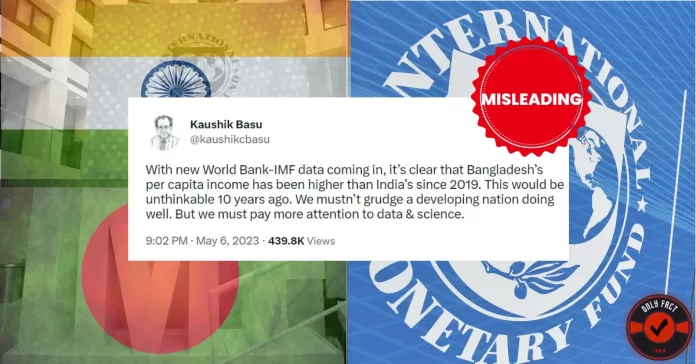Communists and economists are an oxymoron. It signifies that one cannot be both, and those who attempt to sail on both of these boats will perish. Examples include the Communist government in West Bengal for 34 years, China prior to 1980, Cuba, Russia during the Cold War, and so forth. We’ll talk about communism another time; now, we’ll talk about socialist economist Kaushik Basu. Kaushik Basu resides in New York, teaches at Cornell University, and gives socialist talks in India. You see the irony! New York is one of the most expensive cities in the world, and Cornell University is an Ivy League institution with exorbitant tuition fees.
A couple of days ago, Kaushik Basu tweeted, “With new World Bank-IMF data coming in, it’s clear that Bangladesh’s per capita income has been higher than India’s since 2019. This would have been unthinkable 10 years ago. We shouldn’t grudge a developing nation for doing well. But we must pay more attention to data and science.”
Mr Basu is saying that Bangladesh has performed better than India since 2019 in terms of per capita income. He is also implying that India must learn economic lessons from Bangladesh.
Along with Kaushik Basu, a few of his Indian minions tried to sing his tune.
Rohini Singh, an alleged journalist quipped, “A renowned economist uses data to make a point and the bhakt mandali responds in it’s usual churlish, petulant and comical way to this tweet…”
Does Bangladesh, a country from which thousands of refugees enter India at the risk of being apprehended by border security personnel, have a better economic performance than India? We’ll find out the truth down below.
Also Read: No, UK security has not released report disclosing link between Modi and Leicester violence
Fact Check
By conducting a search online for the keywords “IMF Bangladesh GDP per capita” and “IMF India GDP per capita,” Only Fact found the latest 2023 data released by the Indian Monetary Fund, and the results were nothing like Mr Basu’s tweet.
The IMF website had uploaded numerous comparisons between India’s and Bangladesh’s economic data. However, first, we would like to point out the GDP per capita comparison between the two neighbouring countries.
Bangladesh’s per capita income is 2.47 thousand US dollars, whereas India’s per capita income is 2.6 thousand US dollars. As you can see, India’s GDP per capita is higher than Bangladesh’s at 0.13 thousand US dollars.
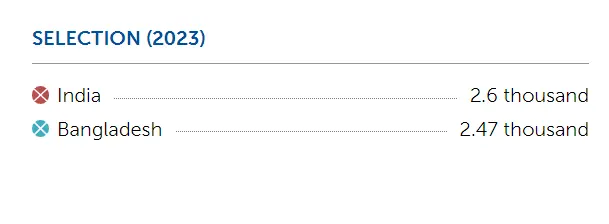
Now, it may not look significant, but the devil lies in the details, into which you will delve in this article.
We looked for news articles significant to this case, and we found that very recently, The IMF warned of threats to Bangladesh’s economy as foreign reserves continue to dwindle.
According to the WION, “The IMF’s warning comes after its recent visit to Bangladesh, during which the organisation assessed the country’s economy.”
The report added, “Bangladesh’s foreign reserves are expected to fall to $29.86 billion, the lowest in seven years, after import payments for two months next week.
The fall in exports and remittances, two key sources of foreign currency, have not helped improve Bangladesh’s current account deficit.
Exports fell 16.5 percent to $3.95 billion in April from a year earlier, as orders from clothing retailers slowed. Inward remittances, on the other hand, declined 16 percent year-on-year to $1.68 billion in April.”
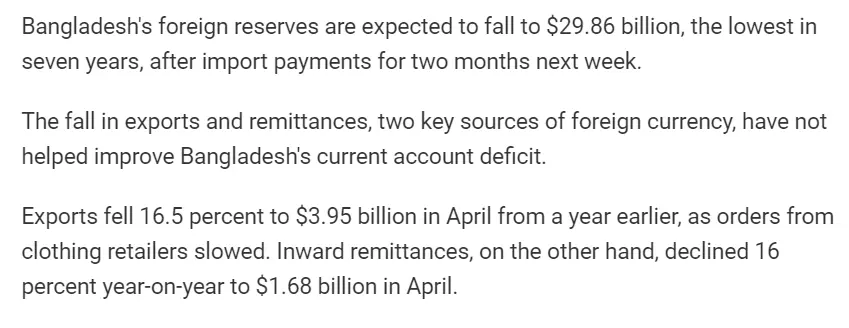
So, now the question you might be asking is why I’m talking about foreign reserves but not about the GDP per capita of Bangladesh.
To further prove my point, I want my readers to understand how the GDP per capita is calculated. The formula to calculate GDP per capita is a country’s gross domestic product divided by its population. For example, there is a country named X with a population of 50 and a GDP of 50,000 rupees. Therefore, GDP per capita will be 50,000 divided by 50, which equals 1,000. It means the per capita income of Country X is Rs. 1,000.
That being said, Bangladesh has increased the value of its currency, the taka, in the black market (kerb market) against the dollar, which means Bangladesh used a fake official exchange rate for the United States dollar. This resulted in a facade of high GDP, hence the higher GDP per capita income. In August 2022, Bangladesh Bank was officially giving Taka for just 95 for every USD. On the kerb market, you can easily get 120 Taka for every USD. Naturally, nobody in their right mind will invest in USD through legal channels.
According to the Financial Times, ‘The new unofficial kerb market rate of dollars was higher by Tk 20 to 25 than its official exchange rate against Bangladeshi currency fixed by Bangladesh Bank, reports UNB.
The greenback maintained its upward trend despite the central bank’s recent steps to punish six major private banks and 10 money exchange houses for irregularities in trading of US dollars.
The dollars sold in the kerb market at Tk 116.60. Riding on high demand after Ashura holiday Wednesday, the price soared up to Tk 120.’

To put it simply, it is a straightforward case of asset valuation. For example, Iqbal has a house for Rs. 50 lakh (real market value), but he believes it is worth Rs. 1 crore. When he meets new individuals, he refers to himself as a crorepati. A similar analogy applies to Bangladesh, which has increased the value of the taka in exchange for the dollar. Bangladesh’s economy was all about smoke and mirrors.
In 2022, Financial Times reported that the IMF advised Bangladesh to avoid forex ‘miscalculation.’ The report further said, “The Washington-based monetary watchdog had raised the issue through submitting Safeguards Assessment Report, January 10, 2022, to the central bank with the mention of few cases of misclassification of the currency assets, which are not high-quality claims on non-residents readily available for meeting balance-of-payments financing needs.”

However, lies don’t age well. Bangladesh is currently experiencing a serious economic crisis. Bangladesh’s export-dependent economy is in a tailspin because no one wants to buy things at such exorbitant costs. Therefore, no export means no dollar. The inflow of remittance is at a record low. Hence the reports of the country’s foreign currency reserves sinking.
Earlier in the article, we showed the data from the IMF that showed India’s GDP per capita is higher than Bangladesh’s. Now, we have shown the reason behind the soaring GDP per capita income of our neighbour.
Mr Kaushik Basu also indicated in his tweet that, we must learn from Bangladesh about how to run an economy. He tweeted, ”We mustn’t grudge a developing nation doing well. But we must pay more attention to data and science.”
Taking Mr Basu’s words at face value, we looked for IMF indicators comparing the various economic parameters of both nations.
According to the IMF, real GDP growth in 2023 for India will be 5.9%, whereas for Bangladesh it’s 5.5%. The inflation rate in India is 4.9%, whereas, in Bangladesh, the inflation rate is soaring at 8.6%. The rest of the indicators are shown below.
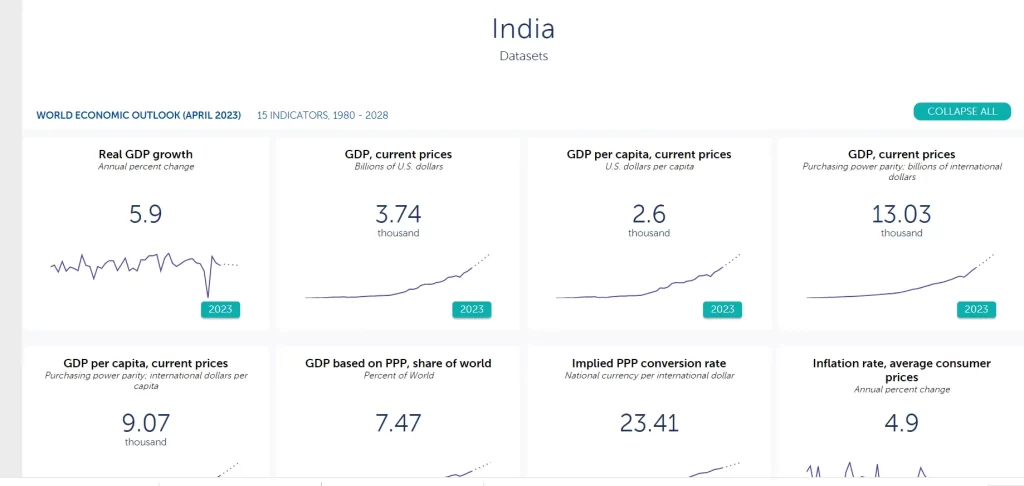
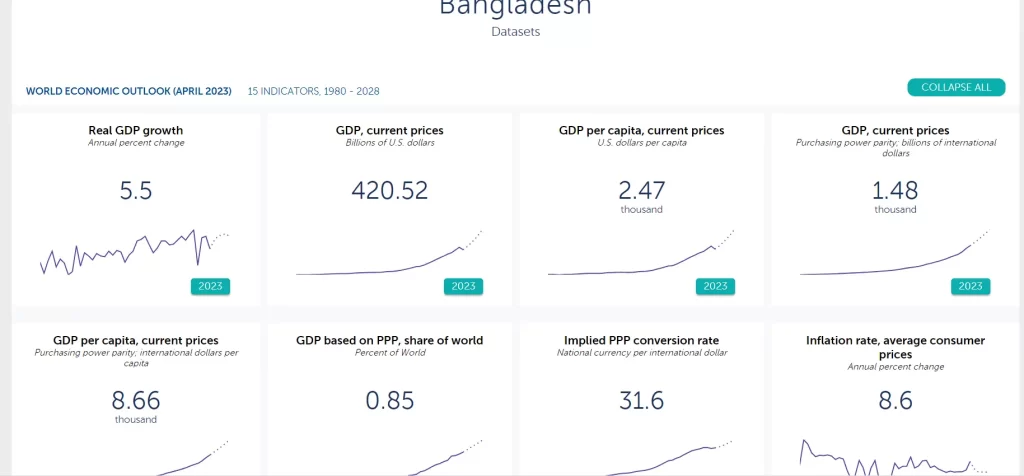
Therefore, now we have established the fact that Bangladesh is in no way economically better than India. On every parameter, Bangladesh falls flat. Moreover, in January, Bangladesh secured a $4.7 billion loan from the IMF to help address mounting economic troubles.
It’s beyond imagination why the economics professor, is making such a ludicrous claim. Then again, they know well that you can comment rubbish on Modi’s India and easily get away with it. More so, the liberals and leftists who have little to no knowledge will always be standing in front, cheerleading the Anti- Indian forces.
| Claim | Indian economy is lagging behind Bangladesh economy in per capita Income |
| Claimed By | Kaushik Basu |
| Fact Check | Misleading |
The goal of the Only Fact Team is to provide authentic news facts and debunk lies to safeguard readers’ interests.
Dear Readers, we are working to debunk fake news which is against India. We don’t have corporate funding like others. Your small support will help us grow further.
If you like our work, support and donate us using the Livix Media Foundation QR code.
Jai Hind!


